|
|
| |
|
 | Search: |
|
|
 |
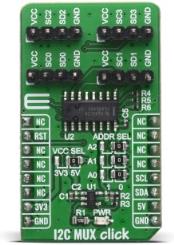
|
|
I2C MUX Click is an quad bidirectional translating I2C and SMBus switch with reset function, intended for applications with I2C slave address conflicts (multiple, identical temp sensors). It features a quad bidirectional translating switch controlled via the I2C bus, labeled as TCA9546A from Texas Instruments. Click has three address jumpers, allowing up to eight TCA9546A devices on the same bus. I2C MUX click allows voltage translation between 1.8V, 2.5V, 3.3V, and 5V buses, and also supports hot insertion. The TCA9546A can work on a 0 - 400 kHz clock frequency range and is ideal for communication with numerous devices that share the identical slave address on the same bus.
I2C MUX Click is supported by a mikroSDK compliant library, which includes functions that simplify software development. This Click board™ comes as a fully tested product, ready to be used on a system equipped with the mikroBUS™ socket.
|
|
|
|
|
 |
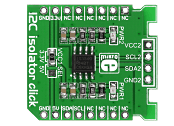
|
|
I2C Isolator click carries ISO1540, a low-power, bidirectional isolator compatible with I2C interfaces. On the board, the Texas Instruments chip is connected to two sets of I2C pins, one on the mikroBUS connector (SDA, SCL), the other on the upper edge of the board (SCL2, SDL2). ISO1540 uses a silicon dioxide barrier that separates the logic input and output buffers. Bidirectional isolators based on TI's Capacitive Isolation technology have many advantages over opto-couplers (performance, size, power consumption etc.). When used together with isolated power supplies, they block high voltages, isolate grounds, and prevent interference from from noise currents. |
|
|
|
 |
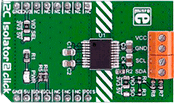
|
|
I2C Isolator 2 click provides I2C lines and power isolation for slave devices. It carries the ADM3260 dual I2C isolator with an integrated DC-to-DC converter. I2C Isolator 2 click is designed to run on either 3.3V or 5V power supply. The click communicates with the target microcontroller over an I2C interface with additional functionality provided by the PWM pin on the mikroBUS™ line. |
|
|
|
 |
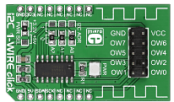
|
|
I2C 1-Wire click carries DS2482, a "bridge device" that performs bidirectional conversions between I2C masters and 1-Wire slave devices. These can be EEPROM chips, temperature sensors and similar devices that have momentary high source current modes. I2C 1-Wire click enables any host with I2C to generate properly timed 1-Wire waveforms to its slave devices. The I2C interface (mikroBUS™ SCL and SDA pins) supports both standard I2C (100kHz max) and fast (400kHz) communication speeds. In addition to the mikroBUS socket, I2C 1-Wire click has an 8-channel pinout (each pin an independently operated 1-Wire I/O). The board is designed to use either a 3.3V or 5V power supply. |
|
|
|
 |
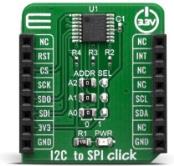
|
|
I2C to SPi Click is an all-in-one solution which allows serving as an interface between a standard I2C-bus of a microcontroller and an SPi bus, which allows the microcontroller to communicate directly with SPi devices through its I2C-bus. It is equipped with the stacking headers, so it can be easily connected. By offering an I2C-bus slave-transmitter or slave-receiver and an SPi master, this Click board™ controls all the SPi bus-specific sequences, protocol, and timing. It also has its own internal oscillator, and it supports the SPi chip select output that may be configured as GPIO when not used.
I2C to SPi Click is supported by a mikroSDK compliant library, which includes functions that simplify software development. This Click board™ comes as a fully tested product, ready to be used on a system equipped with the mikroBUS™ socket.
|
|
|
|
 |
|
|

